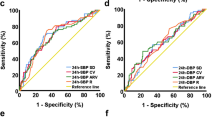Abstract
It is well known that blood pressure is elevated during acute stroke. Despite its importance for cerebral haemodynamics, cardiac output (CO) has been determined only in individual cases during acute stroke. We measured CO and blood pressure in patients with no history of heart disease who suffered from acute stroke (n = 30) and in a control group comparable with regard to age, gender and cardiac health (n = 30). CO, blood pressure and heart rate were significantly (P < 0.01) higher in the group of stroke patients than in the control group. There was a tendency for more time to have elapsed between the onset of symptoms and measurements, the higher the CO [b = 0.08 l/min per hour (−0.01; 0.17)]. Adjusted for age in a multiple regression model, the regression coefficient was significant (CO = 10.35 + 0.094 × time − 0.077 × age). The present study shows for the first time that patients with a healthy cardiovascular system who suffer from acute stroke have a higher CO than a group of comparable controls.
Similar content being viewed by others
References
Adams RJ, Meador KJ, Sethi KD, Grotta JC, Thomson DS (1887) Graded neurologic scale for use in acute hemispheric stroke treatment protocols. Stroke 18: 665–669
Altman DG (1991) Practical statistics for medical research. Chapman and Hall, London
Britton M, Carlsson A, De Faire U (1986) Blood pressure course in patients with acute stroke and matched controls. Stroke 17: 861–864
Britton M, Carlsson A (1990) Very high blood pressure in acute stroke. J Intern Med 228: 611–615
Broderick J, Brott T, Barsan W, Haley EC, Levy D, Marler J, Sheppard G, Blum C (1993) Blood pressure during the first minutes of focal cerebral ischemia. Ann Emerg Med 22: 1438–1443
Carlberg B, Asplund K, Hägg E (1991) Factors influencing admission blood pressure levels in patients with acute stroke. Stroke 22: 527–530
Castor G, Klocke RK, Stoll M, Helms J, Niedermark I (1994) Simultaneous measurement of cardiac output by thermodilution, thoracic electrical bioimpedance and doppler ultrasound. Br J Anaesth 72: 133–138
Clancy TV, Norman K, Reynolds R, Covington D, Maxwell JG (1991) Cardiac output measurement in critical care patients: thoracic electrical bioimpedance versus thermodilution. J Trauma 31: 1116–1121
Fenske A, Kohl J, Regli F, Reulen HJ (1978) The effect of arterial hypertenion on focal ischemic edema. J Neurol 219: 241–251
Fujii K, Sadoshima S, Okada Y, Yao H, Kuwabara Y, Ichiya Y, Fujishima M (1990) Cerebral blood flow and metabolism in normotensive and hypertensive patients with transient neurologic deficits. Stroke 21: 283–290
Haass A, Stoll M, Treib J (1992) Hemodilution in cerebral circulatory disturbances: indications, implementation, additional drug treatment, and alternatives. In: Koscielny J, Kiesewetter H, Jung F, Haass A (eds) Hemodilution. New aspects in the management of circulatory blood flow. Springer, Berlin Heidelberg New York, pp 53–114
Hankey GJ, Gubbay SS (1987) Focal cerebral ischaemia and infarction due to antihypertensive therapy. Med J Aust 20: 412–414
Irie K, Yamaguchi T, Minematsu K, Omae T (1993) The j-curve phenomenon in stroke recurrence. Stroke 24: 1844–1849
Jörgensen HS, Nakayama H, Raaschou HO, Olsen TS (1994) Effect of blood pressure and diabetes on stroke in progression. Lancet 344: 156–159
Lavin P (1986) Management of hypertension in patients with acute stroke. Arch Intern Med 46: 66–68
Lisk DR, Grotta JC, Lamki LM, Tran HD, Taylor JW, Molony DA, Barron BJ (1993) Should hypertension be treated after acute stroke? A randomized controlled trial using single photon emission computed tomography. Arch Neurol 50: 855–862
Mori K, Arai H, Nakajima K, Tajima A, Maeda M (1995) Hemorheological and hemodynamic analysis of hypervolemic hemodilution therapy for cerebral vasospasm after aneurysmal subarachnoid hemorrhage. Stroke 26: 1620–1626
18.Ohtaki M, Tranmer BI (1993) Hyperdynamic therapy for focal cerebral ischemia in rats: use of colloidal volume expansion and dobutamine. Surg Neurol 40: 131–137
Sander D, Klingelhöfer J (1994) Changes of circadian blood pressure patterns after hemodynamic and thromboembolic brain infarction. Stroke 25: 1730–1737
Smith KE, Hachinski VC, Gibson CJ, Ciriello J (1986) Changes in plasma catecholamine levels after insula damage in experimental stroke. Brain Res 375:182–185
Stoll M, Hamann G, Jost V, Schimrigk K (1992) Ein PC-gestütztes System zum Online-Monitoring von neurologischen Intensivpatienten. Biomed Tech 37: 37–41
Treib J, Haass A, Stoll M, Ohlmann D, Koch D (1995) Hemodynamic monitoring of an intensive cardiovascular therapy in ischemic stroke. Cerebrovasc Dis 5: 255
Treib J, Haass A, Stoll M, Grauer M (1996) Monitoring and management of antihypertensive therapy induced deterioration in acute ischemic stroke. Am J Hypertens 9 (in press)
Treib J, Haaβ A, Koch D, Stoll M, Ohlmann D, Schimrigk K (1996) TCD-Untersuchungen über den Einfluβ der Hämodynamik auf die Autoregulation beim akuten Hirninfarkt. Ultraschall Med 17: 64–67
Vander Ark GD, Pomerantz M (1973) Reversal of ischemic neurological signs by increasing the cardiac output. Surg Neurol 1: 257–258
Yamaguchi S, Kobayashi S, Yamashita K, Kitani M (1989) Pial arterial pressure contribution to early ischemic brain edema. J Cereb Blood Flow Metab 9: 597–602
Author information
Authors and Affiliations
Corresponding author
Rights and permissions
About this article
Cite this article
Treib, J., Haass, A., Krammer, I. et al. Cardiac output in patients with acute stroke. J Neurol 243, 575–578 (1996). https://doi.org/10.1007/BF00900944
Received:
Revised:
Accepted:
Issue Date:
DOI: https://doi.org/10.1007/BF00900944




